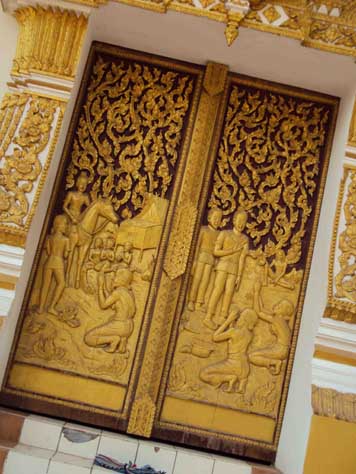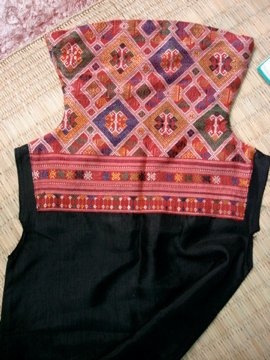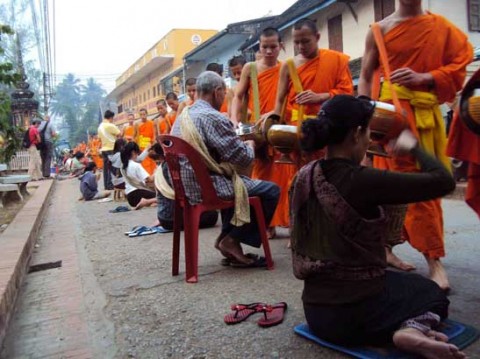

To celebrate the first weekend of our relaunch, we bring you a special report on Contemporary Art in Laos, written by Nathalie Johnston who is studing at the Sotheby’s Institute in Singapore. Laos doesn’t really figure much in our art map when we talk about contemporary practices in South East Asia, however it has vibrant and growing scene and in 2003-2007 was the site of an international community engagement project The Quiet in the Land. This highlight is one of the many which ARTERI will continue to promote in keeping with our interest in contemporary art from the Southeast Asia region. Enjoy and have a great weekend! We’ll be back on Monday! – Eds.

Various Artists, Portrait of Marc LeGuay (top right), Abstract Works, MASK Gallery, 2008/2009
‘Stories say it all began with a man named Marc LeGuay.[1] LeGuay arrived in Laos in 1937 and lived the rest of his days painting the lush greenery and “exotic” scenes of the country. He opened a school for the visual arts and when it closed after two years, he taught at the Lycee Pavie (now the Lycee de Vientiane – the French school in Vientiane, Laos). He married a local woman, named Nang Sang Vane, and painted her going about her daily chores.[2] However, although, he may have influenced contemporary styles in art, Lao creativity embodies a much deeper sense of place, only felt by those who have grown in the care and embrace of the country now known as Lao People’s Democratic Republic.
Where did a quest for the contemporary come from? How did it arrive at such a place that appears stuck in time compared to neighboring Thailand and Vietnam? Taking the past as a starting point, one could say it began thousands of years ago, in the temples. A combination of Buddhism and Animism formed a spiritual environment full of symbolic meaning.[3] These symbols have been interpreted and embraced by the community through textiles, woodwork and magnificent temples unlike any others in Southeast Asia. The art world might label this traditional craft fostered by religious practice. In Laos, it’s called life.
It is not my intention to bring such “craft,” as a Western audience may refer to it, to the forefront of the contemporary art scene in Laos. By focusing on the Buddhist and Animist practice of Laotians along with textile and wood and the ways in which they have evolved, I will attempt to draw a conclusion concerning the state of contemporary art today in Laos and make a projection about how these influences have affected and will affect the future style, medium and message of artists in Laos.

Map of Bombs dropped in Laos during Vietnam War, Cope Visitors Center, Vientiane, March 2010
Before the Thai invaded, or the Japanese, or the Americans gave the country its horrifying historic statistic of most-bombed country in the entire world, Laos was a rich and powerful kingdom, dating from the mid 14th century.[4] As the capital city Luang Prabang was arguably the most magnificent in all of Southeast Asia, with fantastic temples, intricately carved statues, exquisite glass mosaics, and giant golden Nagas, or serpents, guarding the gates of each of the many temples throughout Laos against evil spirits. This tradition of the temple as the center and lifeblood of Lao life spread all over the country and there are now hundreds all over Vientiane, Luang Prabang and other cities. Each supports a group of monks, who are subsequently supported by the members of the local community. Surrounded by such a rich history on a daily basis not only influences the very nature of daily life but the way in which it is interpreted.

Wat Phonexai, Vientiane, March 2010
The Lao textile industry is made up of numerous studios with various projects. It is heavily supported by tourism and has reached international renown. These famous Lao textiles come from a rich tradition of Lao weaving techniques. Within these techniques exists that close connection to the very nature of Lao life – Buddhism. In particular, temple symbols – the diamond pattern, the Naga and the Siho.[5] The diamond is a protective shape. The weavers would incorporate this symbol into traditional materials in order to protect a family home in a wall hanging or a baby wrapped in the patterned cloth. The Naga is a symbol popular throughout Buddhist culture worldwide for its protective properties. It is a serpent and often reinterpreted through loom work, producing beautiful abstractions of this powerful creature. The last, the Siho, a uniquely Lao mythological symbol of half-lion, half elephant, is traditionally woven into a woman’s wedding linens, a sign of fertility. The elderly also use it in their weaving to ward off illness. Interpretations vary depending on the ethnicity of the weaver. The Siho is also a good example of the rare combination of Animism and Buddhism within Lao culture. They come together most often in the form of textiles.

Contemporary Fashion Textile, made by Ock Pop Tock, Luang Prabang, March 2010

Weaver at Mixay Gallery, Vientiane March 2010
Textiles today are given a contemporary edge in various ways throughout the country. Several studios have arisen in order to support the quickly disappearing traditional craft. Disappearance is due to the rising prices of dyes and cloth and the lack of resources for those who carry the skill of weaving and pass it on through their families. However, these studios, such as Carol Cassidy and Mixay in Vientiane, and Ock Pop Tock in Luang Prabang, offer a fresh perspective by creating new patterns and weaving techniques and incorporating contemporary fashions through traditional textiles, all the while teaching local weavers how to do so, thereby creating a possible self-sustaining market.
The simple fact that locals wake up every morning at dawn to drop a handful of steamed rice in each of over 400 monks bowls or that they have continued to hand down a traditional handicraft such as weaving for generations, all the while reinterpreting and reimagining it is only a hint as to why the so-called contemporary art of Laos today is mostly paintings of these very aspects of life: women weaving, worshipping at the temple, monks strolling with parasols, women in traditional dress, the lush banks of the Mekong, the powerful symbols found in the temples and so much more of what one still sees walking down the streets of a Laotian city.
Click here for PART II

Photo, Almsgiving, Morning in Luang Prabang March 2010
~
Nathalie Johnston is from Alexandria, Virginia in the United States. She is studying for her Masters in Contemporary Art in Singapore at the Sotheby’s Institute. In addition to Laos, she has a particular interest in Myanmar and will be writing her thesis pertaining to the performance and environmental artists in Yangon beginning in June. She hopes to remain in Southeast Asia to live, work and pursue her interests in the arts.
[1] Gay, Dr. Bernard. ‘Introduction’. Page 11. Lao Contemporary Art. Treasures of Asia Gallery. Vientiane, Laos. 2007
[2] Image 1 taken from http://sayasackp.free.fr/peinturemarcleguay.htm
[3] Chandra, Lokesh. Buddhism: Art and Values. Rajkamal Electric Press. New Dehli, India. 2007.
[4] Singyabut, Supachai. “Luang Prabang: The Features of Physical Geography and Definition of Settlement.” Message From Heaven: Lao Artists & Lao Students. Ed. Faculty of Fine and Applied Arts, Mahasarakham University. Thailand: M Gallery, 2008. 33-38. Print.
[5] Interview with Carol Cassidy, owner of Carol Cassidy textiles. See Appendix.
Sorry, the comment form is closed at this time.
Thailand, Myanmar, Laos…which of these three countries have the most kickass artwork of mythical monsters you have seen?
The half lion, half elephant Siho (lionephant?) sounds pretty badass or super silly. Picture?
What might be a cool project would be to hook up some animators with the computer school you mentioned, collect stories of Siho and all the rockin crazy heroes and creatures from the Mekong region to make super awesome cartoons that will rival Pokemon!
Imagine serpents from Angkor Wat battling it out on a video game with an Indonesian Garuda etc. You’ll get to keep cha ching and cultural legacy at the same time!It’s a double Win!
I know very little about Laos but I would suggest that what a poor country needs more than carvers, painters, or la-la performance artists right now are really good commercial artists & designers! I hope the galleries investing in Laos artist are investing in ‘high’ art or traditional painters alone.
Over here, designers have entering an early Baroque stage, lots of very decorative and hyper-commercial oh look this colour means I am special yawn yawn work.
Over there, you have the most bombed country right? Designers are the ones who who can make some really easy to use maps and signage to teach young Loatians safety and easy to digest history. The poster featured here looks eye-catching but the data appears too messy. How about school text books, factory training manuals, health related posters? These are the things Laos as a nation needs more.
All the creative energy, resources, and time spent on stuff which mainly tourists and monks should be channel into stuff which will benefit the life of Laos citizens directly.
Your article places great interest in the textile market but relying on it to float the arts industry doesn’t sound too promising to me given the crazy amount of competition this industry faces from all the other traditional and contemporary makers. Sorry, no numbers to justify this, just a hunch.